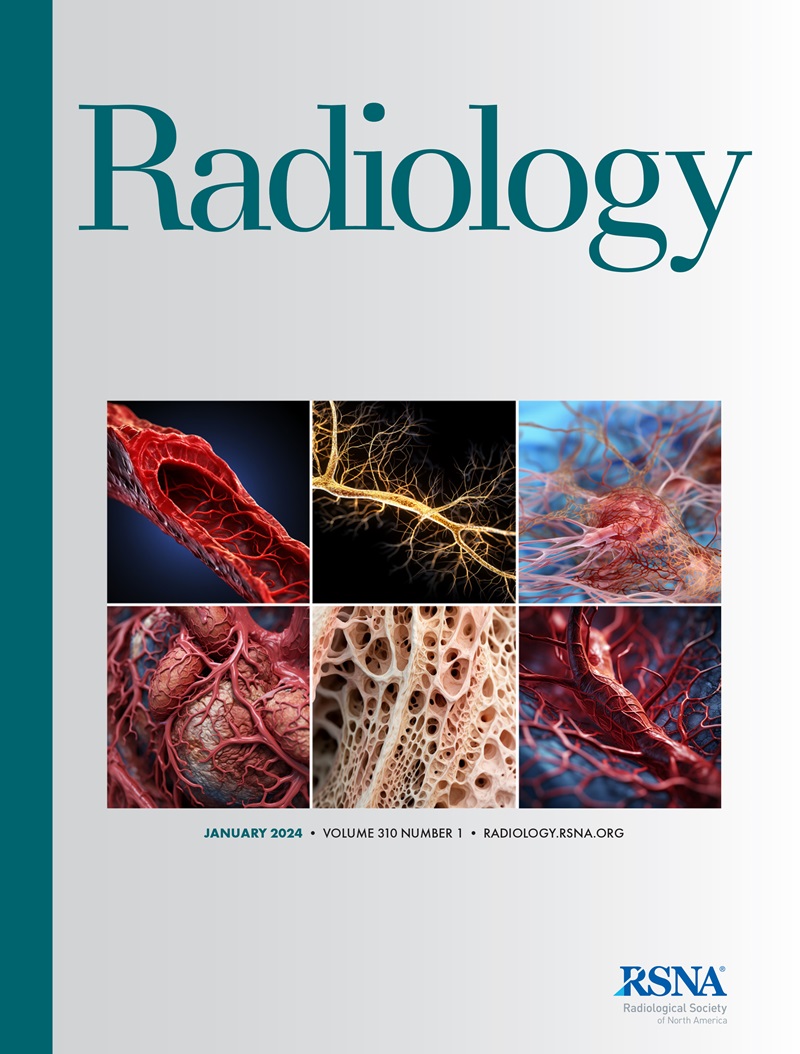Microwave versus Radiofrequency Ablation in Treating Predominantly Solid Benign Thyroid Nodules: A Randomized Controlled Trial.
Sitong Chen, Jianping Dou, Yuancheng Cang, Ying Che, Gang Dong, Chunlai Zhang, Dong Xu, Qinxian Long, Jie Yu, Ping Liang
求助PDF
{"title":"Microwave versus Radiofrequency Ablation in Treating Predominantly Solid Benign Thyroid Nodules: A Randomized Controlled Trial.","authors":"Sitong Chen, Jianping Dou, Yuancheng Cang, Ying Che, Gang Dong, Chunlai Zhang, Dong Xu, Qinxian Long, Jie Yu, Ping Liang","doi":"10.1148/radiol.232162","DOIUrl":null,"url":null,"abstract":"<p><p>Background Current guidelines recommend radiofrequency ablation (RFA) as the first-line treatment for benign thyroid nodules. Purpose To compare the efficacy and safety of microwave ablation (MWA) and RFA for the treatment of predominantly solid benign thyroid nodules. Materials and Methods This prospective, randomized, open-label, multicenter study was conducted from August 2019 to February 2023. Participants with nonfunctioning, predominantly solid benign thyroid nodules from five institutions were randomly assigned with a 1:1 ratio to receive MWA or RFA treatment. Participants were followed up for at least 2 years. Primary outcomes were 6-month and 2-year volume reduction rate (VRR) of nodules after ablation. Secondary outcomes included VRR change over time, complications, and technique efficacy (defined as volumetric reduction ≥ 50% of the initial nodule volume). Continuous variables and categorical variables were compared using the <i>t</i> test and the χ<sup>2</sup> test or Fisher exact test, respectively. Results This study included 76 participants in the MWA group (mean age, 46 years ± 12 [SD]; 58 female participants) and 76 in the RFA group (mean age, 50 years ± 13; 56 female participants). MWA was noninferior to RFA in terms of 6-month (mean difference, -5.6%; <i>P</i> = .01) and 2-year (-2.4%; <i>P</i> < .001) VRR after ablation. Comparing MWA and RFA, no evidence of a difference was observed for VRR change over time (mean difference from mixed-effects analysis, 6.9% [95% CI: -0.5, 13.9]; <i>P</i> = .73) or technique efficacy (91% vs 86%; <i>P</i> = .40). The most common major complication was voice change, which occurred in 6.6% of participants in the MWA group and 1.3% of participants in the RFA group (<i>P</i> = .21). Conclusion MWA and RFA showed comparable efficacy for treating participants with predominantly solid benign thyroid nodules. However, a larger sample size is needed to demonstrate that safety is comparable between the procedures. ClinicalTrials.gov Identifier: NCT04046354 © RSNA, 2024 <i>Supplemental material is available for this article.</i> See also the editorial by McGahan in this issue.</p>","PeriodicalId":20896,"journal":{"name":"Radiology","volume":"313 1","pages":"e232162"},"PeriodicalIF":12.1000,"publicationDate":"2024-10-01","publicationTypes":"Journal Article","fieldsOfStudy":null,"isOpenAccess":false,"openAccessPdf":"","citationCount":"0","resultStr":null,"platform":"Semanticscholar","paperid":null,"PeriodicalName":"Radiology","FirstCategoryId":"3","ListUrlMain":"https://doi.org/10.1148/radiol.232162","RegionNum":1,"RegionCategory":"医学","ArticlePicture":[],"TitleCN":null,"AbstractTextCN":null,"PMCID":null,"EPubDate":"","PubModel":"","JCR":"Q1","JCRName":"RADIOLOGY, NUCLEAR MEDICINE & MEDICAL IMAGING","Score":null,"Total":0}
引用次数: 0
引用
批量引用
Abstract
Background Current guidelines recommend radiofrequency ablation (RFA) as the first-line treatment for benign thyroid nodules. Purpose To compare the efficacy and safety of microwave ablation (MWA) and RFA for the treatment of predominantly solid benign thyroid nodules. Materials and Methods This prospective, randomized, open-label, multicenter study was conducted from August 2019 to February 2023. Participants with nonfunctioning, predominantly solid benign thyroid nodules from five institutions were randomly assigned with a 1:1 ratio to receive MWA or RFA treatment. Participants were followed up for at least 2 years. Primary outcomes were 6-month and 2-year volume reduction rate (VRR) of nodules after ablation. Secondary outcomes included VRR change over time, complications, and technique efficacy (defined as volumetric reduction ≥ 50% of the initial nodule volume). Continuous variables and categorical variables were compared using the t test and the χ2 test or Fisher exact test, respectively. Results This study included 76 participants in the MWA group (mean age, 46 years ± 12 [SD]; 58 female participants) and 76 in the RFA group (mean age, 50 years ± 13; 56 female participants). MWA was noninferior to RFA in terms of 6-month (mean difference, -5.6%; P = .01) and 2-year (-2.4%; P < .001) VRR after ablation. Comparing MWA and RFA, no evidence of a difference was observed for VRR change over time (mean difference from mixed-effects analysis, 6.9% [95% CI: -0.5, 13.9]; P = .73) or technique efficacy (91% vs 86%; P = .40). The most common major complication was voice change, which occurred in 6.6% of participants in the MWA group and 1.3% of participants in the RFA group (P = .21). Conclusion MWA and RFA showed comparable efficacy for treating participants with predominantly solid benign thyroid nodules. However, a larger sample size is needed to demonstrate that safety is comparable between the procedures. ClinicalTrials.gov Identifier: NCT04046354 © RSNA, 2024 Supplemental material is available for this article. See also the editorial by McGahan in this issue.
微波消融与射频消融治疗以实性为主的良性甲状腺结节:随机对照试验
背景 目前的指南推荐将射频消融(RFA)作为良性甲状腺结节的一线治疗方法。目的 比较微波消融术(MWA)和射频消融术治疗以实性为主的良性甲状腺结节的有效性和安全性。材料与方法 该前瞻性、随机、开放标签、多中心研究于 2019 年 8 月至 2023 年 2 月进行。来自五家机构的无功能、以实性为主的良性甲状腺结节参与者按 1:1 的比例随机分配接受 MWA 或 RFA 治疗。对参与者进行了至少 2 年的随访。主要结果是消融后 6 个月和 2 年的结节体积缩小率 (VRR)。次要结果包括 VRR 随时间的变化、并发症和技术疗效(定义为体积缩小≥初始结节体积的 50%)。连续变量和分类变量的比较分别采用 t 检验和 χ2 检验或费雪精确检验。研究结果 MWA 组 76 人(平均年龄 46 岁 ± 12 [SD];女性 58 人),RFA 组 76 人(平均年龄 50 岁 ± 13;女性 56 人)。就消融后 6 个月(平均差异为 -5.6%;P = .01)和 2 年(-2.4%;P < .001)的 VRR 而言,MWA 并不比 RFA 差。比较 MWA 和 RFA,没有证据表明 VRR 随时间的变化而变化(混合效应分析的平均差异为 6.9% [95% CI:-0.5, 13.9];P = .73)或技术疗效(91% vs 86%;P = .40)存在差异。最常见的主要并发症是变声,MWA 组有 6.6% 的参与者发生了变声,RFA 组有 1.3% 的参与者发生了变声(P = .21)。结论 MWA 和 RFA 对治疗以实性良性甲状腺结节为主的参试者的疗效相当。但是,要证明两种方法的安全性相当,还需要更大的样本量。ClinicalTrials.gov Identifier:NCT04046354 © RSNA, 2024 本文有补充材料。另请参阅本期 McGahan 的社论。
本文章由计算机程序翻译,如有差异,请以英文原文为准。


